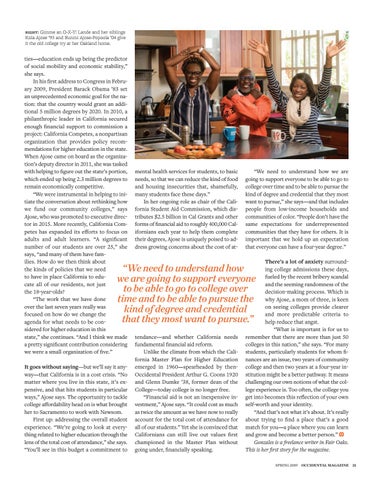right: Gimme an O-X-Y! Lande and her siblings Kola Ajose ’93 and Bunmi Ajose-Popoola ’04 give it the old college try at her Oakland home.
ties—education ends up being the predictor of social mobility and economic stability,” she says. In his first address to Congress in February 2009, President Barack Obama ’83 set an unprecedented economic goal for the nation: that the country would grant an additional 5 million degrees by 2020. In 2010, a philanthropic leader in California secured enough financial support to commission a project: California Competes, a nonpartisan organization that provides policy recommendations for higher education in the state. When Ajose came on board as the organization’s deputy director in 2011, she was tasked with helping to figure out the state’s portion, which ended up being 2.3 million degrees to remain economically competitive. “We were instrumental in helping to initiate the conversation about rethinking how we fund our community colleges,” says Ajose, who was promoted to executive director in 2015. More recently, California Competes has expanded its efforts to focus on adults and adult learners. “A significant number of our students are over 25,” she says, “and many of them have families. How do we then think about the kinds of policies that we need to have in place California to educate all of our residents, not just the 18-year-olds? “The work that we have done over the last seven years really was focused on how do we change the agenda for what needs to be considered for higher education in this state,” she continues. “And I think we made a pretty significant contribution considering we were a small organization of five.”
mental health services for students, to basic needs, so that we can reduce the kind of food and housing insecurities that, shamefully, many students face these days.” In her ongoing role as chair of the California Student Aid Commission, which distributes $2.5 billion in Cal Grants and other forms of financial aid to roughly 400,000 Californians each year to help them complete their degrees, Ajose is uniquely poised to address growing concerns about the cost of at-
“We need to understand how we are going to support everyone to be able to go to college over time and to be able to pursue the kind of degree and credential that they most want to pursue,” she says—and that includes people from low-income households and communities of color. “People don’t have the same expectations for underrepresented communities that they have for others. It is important that we hold up an expectation that everyone can have a four-year degree.” There’s a lot of anxiety surrounding college admissions these days, fueled by the recent bribery scandal and the seeming randomness of the decision-making process. Which is why Ajose, a mom of three, is keen on seeing colleges provide clearer and more predictable criteria to help reduce that angst. “What is important is for us to remember that there are more than just 50 colleges in this nation,” she says. “For many students, particularly students for whom finances are an issue, two years of community college and then two years at a four-year institution might be a better pathway. It means challenging our own notions of what the college experience is. Too often, the college you get into becomes this reflection of your own self-worth and your identity. “And that’s not what it’s about. It’s really about trying to find a place that’s a good match for you—a place where you can learn and grow and become a better person.” Gonzales is a freelance writer in Fair Oaks. This is her first story for the magazine.
“We need to understand how we are going to support everyone to be able to go to college over time and to be able to pursue the kind of degree and credential that they most want to pursue.”
It goes without saying—but we’ll say it anyway—that California is in a cost crisis. “no matter where you live in this state, it’s expensive, and that hits students in particular ways,” Ajose says. The opportunity to tackle college affordability head on is what brought her to Sacramento to work with newsom. First up: addressing the overall student experience. “We’re going to look at everything related to higher education through the lens of the total cost of attendance,” she says. “You’ll see in this budget a commitment to
tendance—and whether California needs fundamental financial aid reform. Unlike the climate from which the California Master Plan for Higher education emerged in 1960—spearheaded by thenOccidental President Arthur G. Coons 1920 and Glenn Dumke ’38, former dean of the College—today college is no longer free. “Financial aid is not an inexpensive investment,” Ajose says. “It could cost as much as twice the amount as we have now to really account for the total cost of attendance for all of our students.” Yet she is convinced that Californians can still live out values first championed in the Master Plan without going under, financially speaking.
spring 2019 OCCIDENTAL MAGAZINE
21
